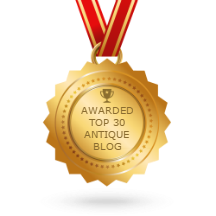
"Why is every English antique called Georgian?" What an excellent question! Oh what the hell, why be diplomatic at this point? That's an incredibly moronic question. But I do understand why someone would ask it.

All English antique furniture is not just called Georgian. But the term "Georgian" covers such a vast period of time that people often think that if it's English and it's really old, then it must be Georgian. But they're wrong.


Watch the movie "The Madness of King George" for details. It's really good. Here's actor Nigel Hoffman as George III when he was nuts:

Semi-interesting factoid: George IV was apparently quite the jerk. Very few people (even at his death) had anything nice to say about him. He was lazy, a glutton, a womanizer, a gambler, a tub-of-lard, and a heroin addict. Wait, that describes most of my friends! Anyhow, George IV was one of England's most despised monarchs.



At this point you may be wondering: "Hey Buzz, if George I, II and most of George III's reigns are all called Georgian, then how come George IV's reign isn't also called Georgian?" And the answer is, "Because I says so." In other words, hey, I don't make up these rules, I just report on them. Or as we used to say in high school (or in my case to this very day), "Like it or lump it." Lovely, huh?

For instance, rather than the extensive carvings that characterizes Jacobean furniture or the frequent use of cabriole legs in Queen Anne furniture, Georgian furniture saw more conservative, imposing designs that reflected the English return to a more neoclassical sensibility. Here's a good example of carved Jacobean furniture, this piece a folding "monk's bench":
.jpg)
And yet when compared to the French Neoclassical Louis XVI and Empire periods, Georgian style is clearly simpler, reflecting England's more conservative/understated penchant (that's a generalization of course and stands in stark contrast to English Palladian furniture which is completely lavish and over the top, but I'll explain that in a later post).


As a general rule, however, it's safe to say that as the 18th century moved from Early Georgian to Mid Georgian, mahogany replaced walnut as the favorite wood of choice. And the George II taste favored lighter color palettes, designs and decoration. And then as George II period was eclipsed by George III, there was a pretty strict return to neoclassical design, with straight lines replacing the curves of the Mid-Georgian period. Again, a generalization but then with Georgian furniture you need to generalize.


The designs of Thomas Chippendale's Directory of 1754 reflect the English taste for the French rococo including Chinoiserie. This represented something of a temporary departure from the classical order and a move towards more whimsical designs, and frequent asymmetry, as shown here:

As the 18th century moved into its last 4o years, we see tremendous innovation in furniture design (such as the sideboard) and the third phase of the Georgian period, George III (Late Georgian).
Late Georgian style is primarily neoclassical as was developed by the likes of Robert Adam. Adam rejected the curves of Rococo and evolved a new style characterized by symmetrical lines, attractive lighter proportions, geometric shapes and an abundance of neoclassical motifs. Take a look at this Robert Adams "Etruscan" room in Osterley Park House, circa 1761:
 George Hepplewhite popularized Adam's designs in his 'Guide' of 1788 while Thomas Sheraton heralded a new era with his 'Drawing Book' of 1791-1794. Furniture of this period is characteristically light and elegant. Straight, tapering legs are typical of Late Georgian chairs, as are geometrical forms and the use of Greek and Roman patterns. Look at the legs of this George III chair and the neoclassical pediment on this George III breakfront:
George Hepplewhite popularized Adam's designs in his 'Guide' of 1788 while Thomas Sheraton heralded a new era with his 'Drawing Book' of 1791-1794. Furniture of this period is characteristically light and elegant. Straight, tapering legs are typical of Late Georgian chairs, as are geometrical forms and the use of Greek and Roman patterns. Look at the legs of this George III chair and the neoclassical pediment on this George III breakfront:


















































